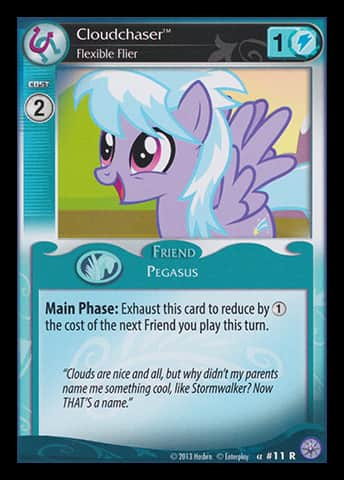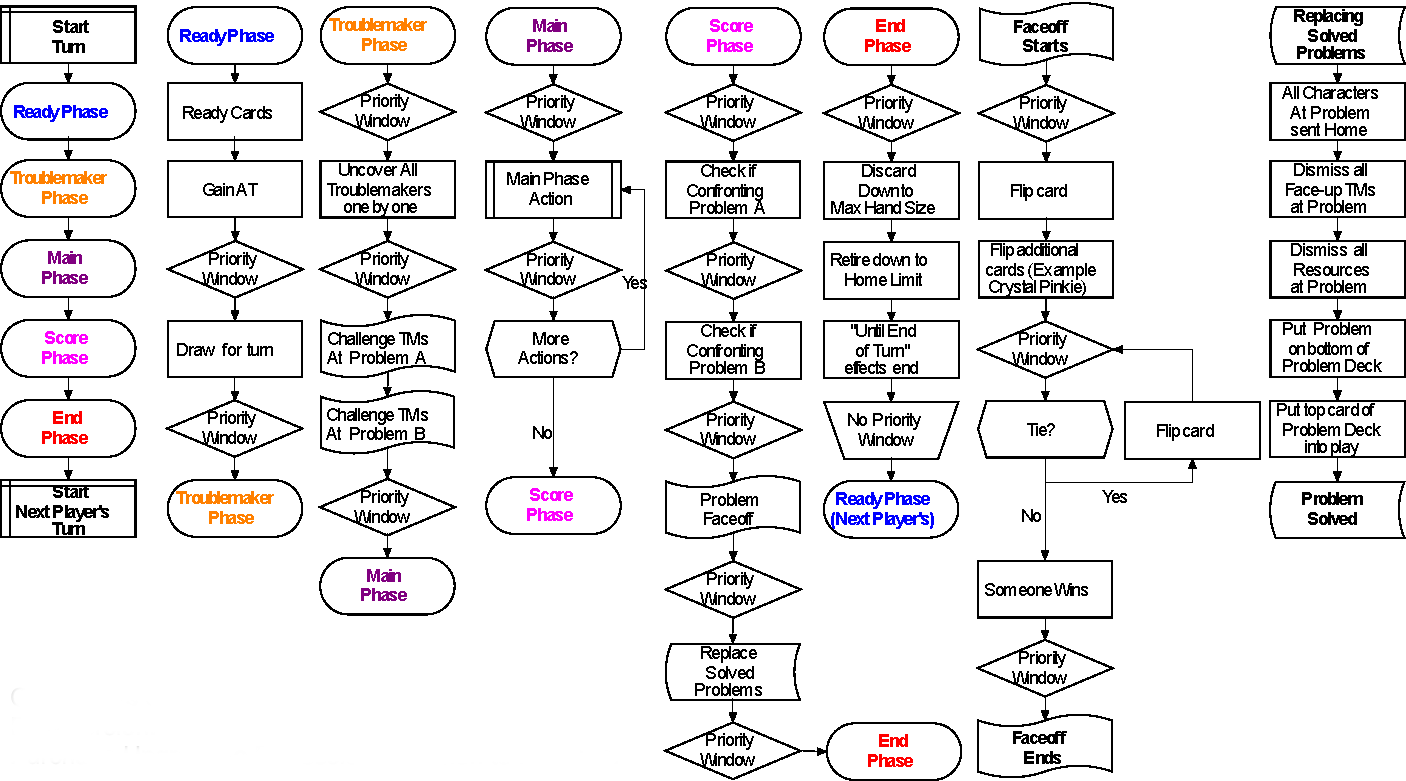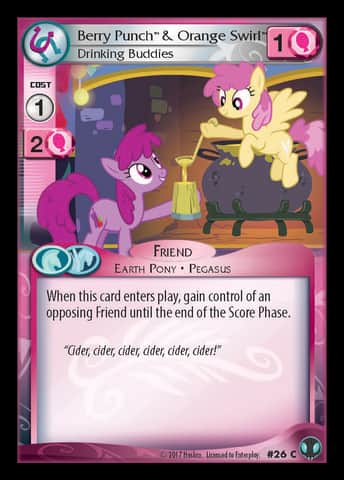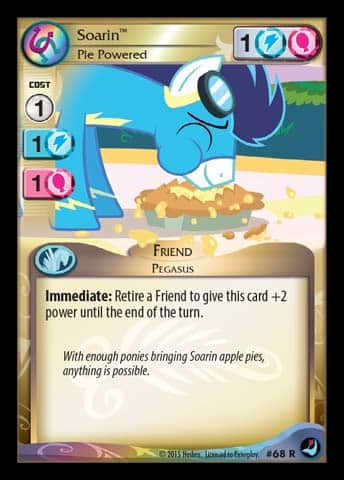Taking Actions
Taking actions is one of the most important aspects of MLP:CCG. That’s how players interact with the game (and thus each other). But what exactly is an action? When you can take an action? “Well, that’s easy”, some may say, “If a card has Immediate on it I can use it any time, and if it has Main Phase I can only use it during my Main Phase”. And that is actually a good enough answer most of the time. But sometimes things are more nuanced than that. For example, did you know that sometimes you can’t take Main Phase actions during your Main Phase? I certainly didn’t at some point!
Today we’re answering the question: which actions you can take when.
What is an action?
First, let’s actually figure out what an action is. Action is one of the following things:
- Playing a card
- Performing a Main Phase action (Pay to move, play a Friend, etc)
- Activating an ability (like on Lemon Hearts, Banquet Planner
 )
)
That’s it! That’s all the actions you can take in the game. Of course there’s more to it than that, but that’s a rough overview.
Priority and Priority Windows
We can’t talk about taking actions without talking about priority. In the rules priority is defined as “an opportunity for a player to take an action”. And it’s what it says on the tin! One of the players (and only one at the time) can have the priority. When a player has the priority they can choose to take an action or pass the priority to their opponent (in which case they lose the priority and the opponent receives it). If you don’t have the priority, you can’t do anything.
If a player chooses to take an action, they fully resolve it and then pass the priority to their opponent.
So simply speaking, when you have the priority you can do something or pass. After you did something it fully resolves, then your opponent gets to do something.
Now let’s talk about priority windows. In the game, players don’t always have the priority, there are moments when neither player has the priority. In fact, the only time players have the priority is during priority windows. At certain moments during a turn a priority window opens and the turn player receives the priority. After both players pass the priority in a row the priority window closes. As a priority window closes, the turn player may still choose to take an action to open a new priority window (in which case they take that action and the priority goes to their opponent afterwards). If they don’t the game moves forward.
Let’s look into more detail how priority windows work. As an example we will take a priority window that opens before a player draws a card at the start of their turn. Player A will the turn player and Player B will be their opponent.
- Turn starts and then a priority window opens before Player A draws a card. Player A receives the priority.
- Player A has nothing to do and passes the priority to their opponent. Player B receives the priority.
- Player B decides to play Napcakes
 on Player A’s Cloudchaser, Flexible Flier
on Player A’s Cloudchaser, Flexible Flier . They
put Cloudchaser on top of Player A’s deck, and then the priority goes back to
Player A
. They
put Cloudchaser on top of Player A’s deck, and then the priority goes back to
Player A - Player A still has nothing to do and passes the priority again. Player B receives the priority.
- Player B also has no more actions they want to take and pass the priority.
- Both players passed the priority in a row, the priority window closes, Player A chooses to not take any more actions, and the turn moves forward (Player A draws a card, and so on)
So now that we know what a priority window is, now we need to know when priority windows open during a turn. First we need to look at the turn sequence:
- Ready Phase
- Ready Step (when you ready all your cards)
- Action Step (when you gain your AT per turn)
- Draw Step (when you draw a card)
- Troublemaker Phase
- Uncover Step (when you uncover your Troublemakers)
- Challenge Step (when you choose to challenge Troublemakers)
- Main Phase
- Score Phase
- Confront Step for each Problem in play (when you check whether you confront the problem)
- Faceoff Step (when you perform a Problem Faceoff)
- Solve Step (when you replace the solved Problems)
- End Phase
- End of Turn Step (when all “at the end of the turn” abilities trigger)
- Wrap Up Step (when you discard cards to your hand limit and retire Friends to your Home Limit)
A priority window is opened at the start and end of each step and each phase or in-between each item on the list above, but with some exceptions:
- There are no priority windows up until after Action Step
- There are no priority windows after Wrap Up step
Here’s a very helpful turn structure chart with all the priority windows in it:

Disclaimer: the chart isn’t made by me, I took it from Reddit
To recap: during a turn, there are priority windows during which players receive priority to take actions.
Timing rules
Priority by itself isn’t very interesting. While it does define when you can take an action, it doesn’t define which actions you can take. This is when timing rules come into play. Many cards have so-called “Timing phrases” that specify when you can play that card or activate that ability. On cards you can find timing phrases emboldened followed by “:“. Here’s a list of all of them:
- Immediate
- [*] Faceoff (Examples: Faceoff, Problem Faceoff, etc)
- [*] Reaction
- [*] Phase (Examples: Main Phase, Troublemaker Phase, etc)
In addition to timing phrases on cards, there are also additional Main Phase actions defined by the rules:
- Play a Friend or a Resource
- Pay to draw a card
- Pay to play a Troublemaker
- Pay to move one of your characters
- Pay to rally one of your Friends.
Notice that you can only play Friends and Resources (and Troublemakers) as a Main Phase action (unless they’re Hasty of course).
Now let’s review what each timing phrase means!
Immediate

A very well known Immediate card
Immediate is the simplest one. You can take an Immediate action whenever you have the priority. As simple as it gets!
In fact, ever since Equestrian Oddyseys Faceoff and Reaction have been
completely replaced by Immediate. You can even see text like
“Immediate: During a faceoff …” on newer cards, like Sunset Shimmer, Clever Calculator
[*] Faceoff

A not so known Faceoff card
Faceoff is just like Immediate, except you can take a Faceoff action only during a faceoff. Some Faceoff timing phrases are prepended with an additional constraint of which type of a faceoff they can be taken in, e.g. Troublemaker Faceoff.
[*] Reaction

Was soaring high in skies and clouds, until someone read rules aloud.
Now Reaction is a little bit more interesting. Just like Immediate or Faceoff you can only take Reaction actions (that’s a fun thing to say) whenever you have the priority. Similarly to Faceoff a Reaction timing phrase might be prepended with an additional constraint, e.g. Faceoff Reaction.
However, unlike Faceoff and Immediate all of the Reaction abilities/cards have also a condition written in their text. If the condition was met since the last time a priority window was closed, you can take a Reaction action, but no more than the same action once.
So as we learned previously at the start of any phase a priority window opens
and the turn player receives the priority. Let’s imagine this situation: you
have Eagle, Soaring Raptor at home with 3 cards beneath it, your opponent moves to
Score Phase and you want to move your Eagle. When the phase starts a priority
window opens and now your opponent has the priority. After they do something or
pass it, you receive the priority. Now let’s check if we can use Eagle’s
Reaction condition is met (“at the start of any phase <…>“). Last time a
priority window was closed was in Main Phase and now you’re in Score Phase. So
since then the Score Phase has started thus Eagle’s condition is met and you can
take that action. Once you do that you won’t be able to use that action again
until the condition was met again.
at home with 3 cards beneath it, your opponent moves to
Score Phase and you want to move your Eagle. When the phase starts a priority
window opens and now your opponent has the priority. After they do something or
pass it, you receive the priority. Now let’s check if we can use Eagle’s
Reaction condition is met (“at the start of any phase <…>“). Last time a
priority window was closed was in Main Phase and now you’re in Score Phase. So
since then the Score Phase has started thus Eagle’s condition is met and you can
take that action. Once you do that you won’t be able to use that action again
until the condition was met again.
Important to note that you can take multiple different Reaction actions for
the same condition. So if you have 2 Eagle, Soaring Raptor in play instead of one, you
can activate both of them (one at a time).
in play instead of one, you
can activate both of them (one at a time).
Or you can even take some other actions before taking a Reaction Action as long as the current priority window didn’t close (again, the condition is met as long as it was met since the last time a priority window was closed)!
[*] Phase

“I exhaust Twilight for AT”
Now this is when it gets interesting. Unlike all other timing phrases, * Phase actions are not and can’t be taken when you have the priority!
First and foremost, you can take * Phase actions only when you’re in that phase and only during your turn. Second they can’t be taken during a faceoff. Third, you can take a * Phase action only as a priority window closes. If you do that, a new priority window opens, you process the action and then the priority is passed to your opponent.
Why is this important? Let take a look at an example. Player A has Method Mares, Convincing Act in play. Their opponent, Player B, has Berry Punch & Orange Swirl, Drinking Buddies
in play. Their opponent, Player B, has Berry Punch & Orange Swirl, Drinking Buddies and Soarin, Pie Powered
and Soarin, Pie Powered in play. It’s Player A’s Main Phase.
in play. It’s Player A’s Main Phase.
- Player A plays Princess Twilight Sparkle, Cover to Cover
 as a Main Phase action. A new priority window
opens, and their opponent receives the priority.
as a Main Phase action. A new priority window
opens, and their opponent receives the priority. - Player B plays Interdimensional Portal
 banishing their Drinking Buddies and putting
them back into play taking control over Cover to Cover. Player A receives the
priority.
banishing their Drinking Buddies and putting
them back into play taking control over Cover to Cover. Player A receives the
priority. - Now Player A sees right through Player B’s plan. Player B wants to retire Cover to Cover to Soarin as soon as they get the priority again. Player A wants to respond with activating Method Mare’s ability, but they can’t! That ability is Main Phase and you can only activate those as a priority window closes. So even though Player A is indeed in their Main Phase and they do have the priority they can’t take Main Phase actions, they can only take Immediate actions.
And one more example just in case. Player B has Pile of Presents and 3 DJ Pon-3, Everypony's Shufflin'
and 3 DJ Pon-3, Everypony's Shufflin' in play and they are at 9 points. It is start of Player’s A Main Phase.
in play and they are at 9 points. It is start of Player’s A Main Phase.
- At the start of Main Phase a priority window opens and Player A receives the priority.
- Player A has Special Beam Cannon
 in hand but they can’t use it because it is
Main Phase, they can only use it as a priority window closes. With nothing
else to do Player A passes the priority. Player B receives the priority.
in hand but they can’t use it because it is
Main Phase, they can only use it as a priority window closes. With nothing
else to do Player A passes the priority. Player B receives the priority. - Player B activates DJ’s Reaction. Both players draw 4 cards, Player B scores 2 points, because it is currently opponent’s Main Phase.
- Player A passes again.
- Player B activates another DJ’s Reaction, this times scoring 4 points. Player B wins the game.
Note: This is no different for Main Phase actions like moving, rallying, etc.
Conclusion
That’s pretty much everything you need to know about which actions you can take when. Let’s recap:
- When players have the priority they take an action, then the priority goes to the opponent
- Players receive the priority only during certain times called priority windows
- Different timing phrases specify when you can take those actions
- * Phase actions are special as they can’t be taken when you have the
priority, instead you can take them as the priority window closes in the
corresponding phase.
I hope this post has been helpful to you and maybe you even learned something new!